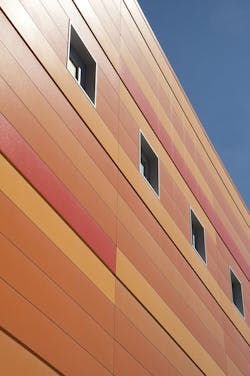What defines a good, better or best coating system?
Resins, the base ingredient in any coating, vary in performance qualities from good to better to best. Selecting the right coating for the specific application and desired effect is key.
• A polyester coating is a good generic polymer system with limited weather performance and can achieve a wide variety of colors.
• A silicone polyester is better and acts to improve the gloss retention and weather resistance.
• A fluoropolymer coating is the best, providing the strongest carbon-fluorine chemical bond known with a slippery finish that enables pollutants to wash away.
Environmental conditions will influence the recommended coating system, including primer, color coat and clear topcoat. Each system must be selected carefully, considering the substrate, coil coater, chemical conversion/pretreatment, primer and finish coat. Testing procedures will assure high performance of coatings technology and may include ASTM; AAMA 2605, 2604, 2603; online coating quality checks/visual inspection; and natural exposure sites for atmospheric environmental testing. Accelerated lab testing occurs in special environmental cabinets that are utilized to speed up the weathering process to measure under extreme conditions; tests may include corrosion (salt spray), humidity, UV exposure, dew cycle and abrasion resistance. Accelerated lab testing does not replace real world natural exposure, but it can be used to help test and evaluate a coating’s performance.
Whether coating an architectural wall requiring a pearlescent or intense sparkle effect, or coating a product for a corrosive, heavy industrial environment, selecting the strongest coating option for the application is critical. No matter how well a coating is made, if the wrong ingredients are selected for the application, it has the potential to fail.

